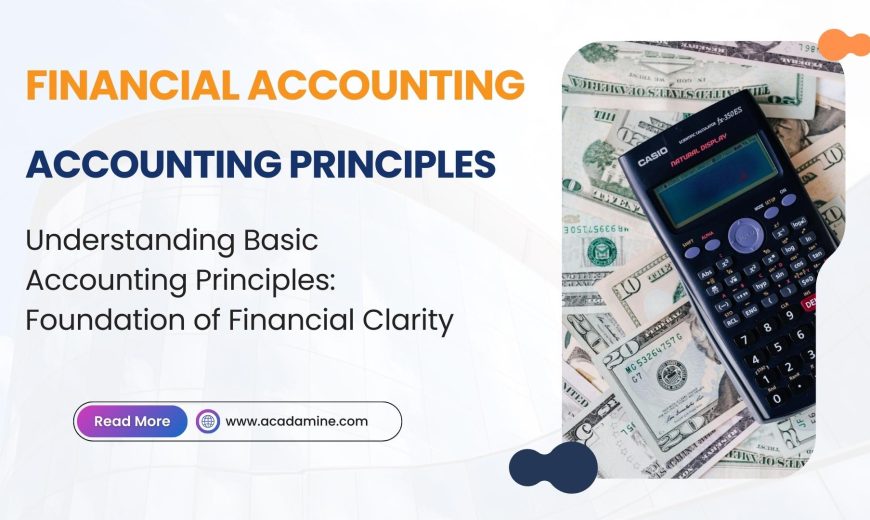
Accounting may seem like a rigid, number-heavy practice, but at its core, it’s both a science and an art. While it’s grounded in systematic rules and principles, it requires judgment, interpretation, and a deep understanding of business dynamics. To make sense of the financial world, accountants rely on a framework of established principles that ensure accuracy, consistency, and transparency in reporting. These principles aren’t just theoretical—they guide real-world business decisions, large and small.
Let’s break down the most fundamental accounting assumptions, principles, and conventions that form the bedrock of financial reporting today.
The Scientific Nature of Accounting
Accounting is often called the “language of business” for a good reason. Just like language has grammar rules to ensure clear communication, accounting has principles that help businesses share financial information reliably and understandably. These principles are not based on random choice; they’ve evolved from consistent practices and observations, backed by logic and real-world application.
While accounting isn’t a “pure” science like physics or chemistry, it does follow a scientific approach—observing financial activity, recording it systematically, analyzing data, and making informed decisions based on evidence. The goal? To provide an accurate and fair view of an organization’s financial health.
Basic Accounting Assumptions: Laying the Groundwork
Before discussing detailed principles, it’s important to understand the basic assumptions that shape all accounting practices. These assumptions form the foundation for more complex rules.
1. Separate Business Entity Concept
Imagine a lemonade stand owned by a teenager. The cash used to buy lemons comes from their savings—but once that money enters the business, it’s no longer personal. This is the essence of the separate entity assumption.
Under this concept, a business is treated as distinct from its owners or shareholders. Even if a sole proprietor technically owns the business legally, accounting draws a clear line between personal and business transactions. This is important because it prevents confusion and ensures that financial reports reflect the business alone—not the owner’s grocery bills or family vacation expenses.
This separation is vital for evaluating a company’s performance, assessing profits, and making financial decisions without the clutter of unrelated personal activity.
2. Going Concern Concept
Think of a business as a marathon runner. The going concern assumption assumes the runner will keep moving forward unless there’s clear evidence otherwise.
In accounting, a business is expected to operate indefinitely, or at least for the foreseeable future. Unless there’s a strong reason to believe otherwise—like bankruptcy or liquidation—accountants assume the business will continue running. This assumption allows companies to record long-term assets and liabilities, allocate costs over time (like depreciation), and avoid panic-driven decisions based on the idea that they might shut down tomorrow.
If a company were closing soon, its financial reports would look very different—asset values would reflect what it could fetch in a quick sale, not what it’s worth over time.
3. Accounting Period Concept (Period Assumption)
Businesses never sleep, but reports have to. That’s where the accounting period concept comes in.
Rather than waiting until the end of a business’s life to evaluate performance, accountants break time into smaller, more manageable chunks—typically months, quarters, or years. This helps companies track progress, spot trends, and report regularly to investors, lenders, and other stakeholders.
Think of it like using monthly report cards in school. You wouldn’t wait until graduation to find out how you’re doing. The same idea applies here—regular intervals make performance measurable and actionable.
4. Money Measurement (Monetary Unit Assumption)
You can’t measure everything in dollars, and that’s precisely why this assumption matters. The monetary unit concept states that only events that can be quantified in economic terms are recorded in financial statements.
Let’s say your company has excellent customer service or high employee morale—those are great things, but they don’t go on the balance sheet because they can’t be reliably measured in currency. Instead, only transactions like purchases, sales, salaries, and rent—anything that involves actual or estimable money—are included.
This principle helps maintain objectivity and clarity in financial records, making comparing data across companies and periods easier.
Core Accounting Principles: The Rules That Guide Reporting
Building on those assumptions, accounting principles provide a standardized framework for recording and reporting financial activity. These are universally accepted and ensure that financial statements are trustworthy and comparable.
1. Duality Concept (Dual Aspect Principle)
At the heart of accounting lies the principle of duality. Every financial transaction affects at least two accounts—one that gives something and one that receives.
This is captured in the fundamental accounting equation:
Assets = Liabilities + Equity
If a company borrows $10,000 from the bank, it gains cash (an asset) but also owes money (a liability). The books must reflect both sides. This “debits and credits” system ensures that accounts always stay balanced and accurate.
It’s like a see-saw—every up has a down, and if the balance is off, something’s gone wrong.
2. Matching Principle
Imagine selling holiday decorations in December but paying for production back in October. The matching principle ensures that the expenses related to those sales are recorded in the same period as the revenue.
Why does this matter? Without it, your profit margins would be misleading. You might look like you lost money in October and made tons in December, but it was one cycle.
This principle links revenue and expenses simultaneously, offering a more accurate view of profitability. It’s essential for sound financial analysis and budgeting.
3. Timeliness Concept
In accounting, timing is everything. The timeliness concept insists that financial data must be recorded promptly and in the order in which it occurs.
Delayed reporting can distort the picture. For instance, waiting months to record a significant expense may make your financial statements seem stronger than they are. Timely data is crucial for decision-makers, whether a manager is planning next month’s budget or an investor is considering buying stock.
Staying current isn’t just good practice—it’s necessary in today’s fast-moving world.
4. Full Disclosure Principle
Transparency builds trust. The whole disclosure principle requires companies to share all material information that could influence decisions made by users of financial statements.
This includes notes about pending lawsuits, major upcoming expenses, or significant risks. Even if something isn’t directly recorded in the main financial statements, it should be disclosed in the footnotes.
For example, if a company knows it has a large debt repayment due soon, it must disclose that—even if it hasn’t paid yet. These “footnotes” can span several pages but offer invaluable context for analysts and investors.
5. Historical Cost Principle
Think of this as the “original price tag” rule. Under the historical cost principle, assets are recorded at the amount paid at the time of purchase, not their current market value.
This approach brings consistency and objectivity. If a company bought a building for $500,000 in 2000, it stays on the books at that price—even if it’s worth $2 million today. The value won’t change unless the company sells it or there’s objective evidence for reassessment.
This avoids speculation and keeps financial records grounded in fact. There are exceptions, but historical cost remains a cornerstone of conservative accounting.
6. Revenue Realization Principle
This principle answers the question: When is revenue truly “earned”?
Under this concept, revenue is recognized only when a product is delivered, or a service is completed—not when cash changes hands. So, if you perform consulting services in March but get paid in April, you record the revenue in March.
It prevents businesses from counting money too soon and gives a clearer picture of performance in each period.
Accounting Conventions
Beyond assumptions and principles, accountants follow time-tested conventions that provide flexibility and practical wisdom in applying rules.
1. Consistency Convention
Consistency is key to creating useful financial statements year after year. If a company uses one method to value inventory this year and another next year, comparing the results becomes difficult.
This convention encourages the use of the same accounting methods over time. If a change is made, it must be clearly disclosed along with the reason.
Consistency builds trust and allows investors, auditors, and managers to spot trends and make informed comparisons across time.
2. Materiality Concept
In accounting, not everything is worth the same level of attention. The materiality concept focuses on what’s significant enough to matter in decision-making.
Small, insignificant items can be recorded in a simplified way to save time and avoid clutter. For instance, a $10 office item doesn’t need to be depreciated over 10 years—it can be written off as an expense immediately.
This allows accountants to apply professional judgment and focus on the big picture without getting bogged down in trivial details.
3. Objectivity Principle
Every number in accounting should be backed by verifiable evidence. That’s the essence of objectivity.
Receipts, invoices, contracts, or similar documentation must support transactions. Without this, financial data becomes less reliable and more prone to manipulation.
Objectivity ensures that statements are based on facts, not opinion or guesswork—a crucial factor in audits, legal compliance, and investor confidence.
4. Conservatism Principle
“Hope for the best, prepare for the worst.” That’s the spirit behind the conservatism principle.
When faced with uncertainty, accountants choose the less optimistic route—recording potential losses but not unrealized gains. This approach prevents overstatement of assets or income, protecting stakeholders from misleading reports.
For example, if a company expects to sell an asset for a profit, that gain isn’t recorded until it happens. But if there’s a risk of loss, it’s disclosed immediately.
Why These Principles Matter
These assumptions, principles, and conventions ensure that financial statements reflect reality, promote transparency, and foster trust. They allow companies to communicate clearly with investors, creditors, regulators, and the public.
In most countries, publicly traded companies must follow a set of rules known as Generally Accepted Accounting Principles (GAAP) or International Financial Reporting Standards (IFRS). These standards unify financial reporting, making comparing performance across businesses and industries easier.
Final Thoughts
Understanding these accounting principles is like learning the road rules before driving. They guide how information is recorded, reported, and interpreted, ensuring that financial statements are not only accurate but meaningful.
Whether you’re a student exploring the field, a business owner managing finances, or an investor reading balance sheets, these principles offer clarity in a world of numbers. They turn raw data into a story of how a business is performing, growing, and preparing for the future.


